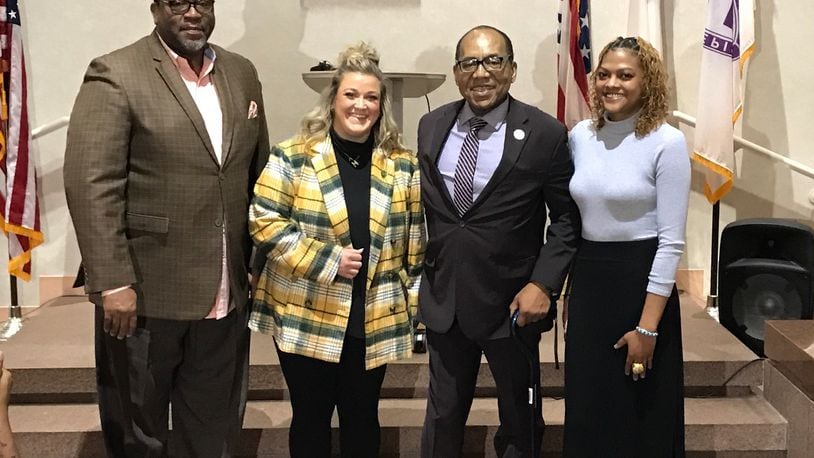When he picked up the microphone, Newkirk smiled and said he was scrapping the long poem he was going to read, and he also was jettisoning the story from his childhood about a donkey.
“I thought I’d start off with a song from my favorite group, the Stylistics,” he said, as his voice shifted register to the famous falsetto of the old Philadelphia soul group.
He got out just a few words and the crowd roared.
Truth be told, he should have been singing a different Stylistics hit:
“You Make Me Feel Brand New.”
That’s much of what this press conference was about.
A brand-new feel about Bulldog athletics is beginning to take shape.
Tuesday’s gathering was to announce that the university is joining the Gulf Coast Athletic Conference (GCAC), which is currently a 10-school league and next year will expand to 13 with the addition of Wilberforce, Stillman College and Voorhees University.
It’s the only conference made up of Historically Black College and University (HBCU) schools in the NAIA.
To become a member, Wilberforce needed to add some new sports to the six athletic teams it now fields.
And so, beginning next season, WU will have women’s volleyball coached by Jasmine Coleman, a former standout athlete and coach at Rust College in Mississippi; and women’s soccer, coached by Meagan Moran, who starred at Beavercreek High and played at Bowling Green State University, before coaching a top club soccer team in the Dayton area and working the past six years in the human resources department at Wilberforce as the payroll manager.
The new league and new sports will help the school “bolster our recruitment of students,” said the Bulldogs new athletic director and interim women’s basketball coach John Hill.
He said the school is aiming for an enrollment of 1,000 students.
“At present enrollment is closer to 700,” said Steve Miller, the school’s new Vice President of Institutional Advancement and a Wilberforce grad. “Our enrollment is up about 30 percent. Last year it dipped down to under 400.”
Newkirk touched of the school’s resurgence in his remarks.
“Think about all the small schools that have gone out of business this year,” he told the crowd. “We’re still standing!”
Morphing from president to preacher, he urged the crowd to repeat the line:
“We’re still standing!”
And as an aside, he noted more quietly: “Since 1856.”
Wilberforce is the nation’s oldest private HBCU owned and operated by African Americans. Over the years — and especially in recent times — it has faced some real challenges. But there are a lot of changes taking place now on the rural Greene County campus.
First, you noticed all the people who spoke Tuesday are new. Newkirk, previously the president at Fisk, took over at Wilberforce seven months ago.
Hill, who had been a college athlete at Greensboro College, coached at several HBCUs and most recently was at Goldey Beacom College, a private, non-HBCU in Wilmington, Delaware, took over in August.
Miller, once a basketball player at the University of Norh Carolina-Greensboro, joined Wilberforce from the United Negro College Fund in October.
The school is in the process of building 10 modular apartment complexes on campus to house the influx of expected students. At present, 150 of its students are living across the street in housing at Central State.
New, year-round academic programs have been added to help students adjust to the academic and social rigors of college and now there is the expansion of the athletic programs.
Miller talked about how sports can open be “the face of the school” and Hill noted while they not only draw outside interest to their university, the bolstered athletic programs can foster a sense of spirit and camaraderie among students and faculty on campus.
And with many students coming from urban areas and away from home for the first time — and because Wilberforce is located in the farmlands beyond Xenia — there’s a need for more things to do on campus.
Miller also said the school has talked to the University of Dayton about hopefully hosting the annual next-door basketball rivalry between Wilberforce and Central State at UD Arena next year as a way of drawing HBCU grads from both universities to a featured event.
While the schools in the new conference are based in seven southern states and there’s also the University of Virgin Islands, Hill said Wilberforce would be able to play two or three schools at a central location to make travel easier and less expensive. It also would mean Wilberforce would get far more basketball home games than it has now.
Both new coaches are young — Moran is 35 and Coleman is 26 — and they spoke of the excitement of building their own programs.
Coleman grew up on a Navajo reservation in Arizona and said she learned long ago from her parents: “You may have nothing, but if you push forward, you can build something from the ground up.”
Moran said while working at Wilberforce the past six years — and coaching soccer elsewhere on the side — she often lobbied to start a program at the school.
“Now it’s finally happening and its exciting,” she said. “It feels good.”
Somewhere in the background President Newkirk, in Stylistic falsetto, should have been singing:
“You make me feel brand new.”
About the Author
